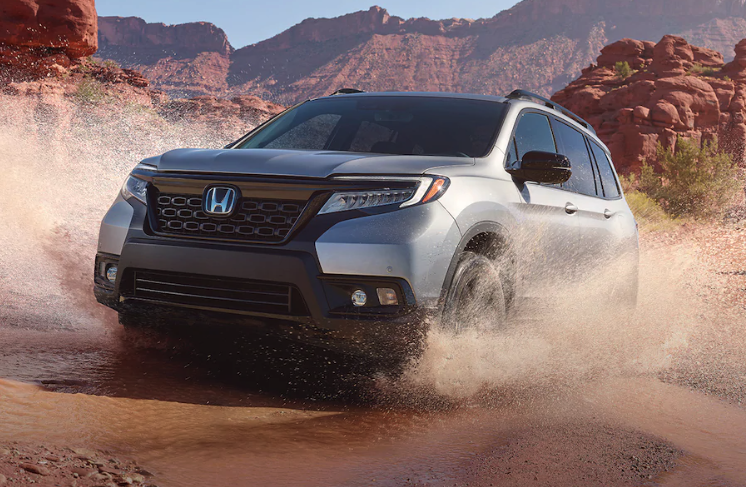When it comes to choosing the perfect SUV for your lifestyle, it can often feel like navigating a maze of options. Two popular contenders in Honda’s lineup are the Passport and the Pilot, each offering its own unique blend of space, comfort, and performance. Whether you’re an adventurous spirit seeking off-road thrills or a busy family in need of ample room for all your gear, understanding the distinctions between these two models is key to making an informed decision.
In this article, we’ll dive into the features, capabilities, and practical considerations of the Honda Passport and Pilot, helping you determine which SUV aligns best with your needs and preferences. So buckle up as we explore what these two impressive vehicles have to offer!
Table of Contents
- Understanding the Key Differences in Size and Space
- Exploring Performance and Handling for Every Adventure
- Evaluating Technology and Safety Features for Family Needs
- Choosing the Right Trim and Options for Your Lifestyle
- Q&A
- Concluding Remarks

Understanding the Key Differences in Size and Space
When comparing the Honda Passport and Pilot, one of the most noticeable differences lies in their dimensions and space utilization. The Passport is designed to be a more rugged and adventurous SUV, offering a compact yet spacious interior that comfortably seats five passengers. With its shorter wheelbase and overall length, it is easier to maneuver in tight spaces, making it a suitable choice for urban dwellers or those who frequently navigate crowded areas. Additionally, the Passport boasts a generous cargo capacity, perfect for weekend getaways or outdoor adventures, allowing for up to 77.9 cubic feet of storage when the rear seats are folded down.
In contrast, the Pilot is the larger of the two, providing a three-row seating arrangement that accommodates up to eight passengers, making it an excellent choice for families. Its extended dimensions offer more legroom and headroom across all three rows, ensuring a comfortable ride for everyone. The Pilot also features an impressive cargo space, with up to 83.9 cubic feet available with the rear seats down. When considering these SUVs, it’s important to assess your specific space requirements and how you plan to utilize the vehicle on a daily basis.
Exploring Performance and Handling for Every Adventure
When comparing the Honda Passport and the Honda Pilot, performance is a pivotal factor that can sway your decision. The Passport boasts a robust 3.5L V6 engine, delivering an impressive 280 horsepower paired with a smooth 9-speed automatic transmission. This power allows for a confident ride both on highways and off the beaten path. Notably, its i-VTM4 AWD system enhances traction during inclement weather and rugged terrains, making it an ideal companion for outdoor enthusiasts. On the other hand, the Pilot also features the same powerful V6 engine but offers a different driving experience due to its emphasis on family comfort and versatility.
Handling is where the two models start to differentiate themselves. The Passport, with its shorter wheelbase and more rugged design, leans toward a sporty, adventurous feel, perfect for weekend getaways and spontaneous road trips. It comes equipped with a multi-link rear suspension that provides better stability during sharp turns and uneven surfaces. In contrast, the Pilot focuses on spaciousness and comfort, featuring a soft suspension system that absorbs bumps and facilitates a smoother ride for passengers. Depending on your lifestyle—whether you prioritize adventure or family comfort—your choice between the two SUVs may hinge on their distinct handling characteristics.
Evaluating Technology and Safety Features for Family Needs
When it comes to choosing the right SUV for your family, safety features and technology play a crucial role in the decision-making process. Both the Honda Passport and Pilot come equipped with a range of advanced safety technologies designed to protect your loved ones on the road. Key features to consider include:
- Adaptive Cruise Control: Allows for automatic speed adjustments based on traffic conditions.
- Lane Keeping Assist: Helps maintain your vehicle’s position within its lane.
- Collision Mitigation Braking System: Detects potential collisions and automatically applies brakes if needed.
- Blind Spot Monitoring: Alerts you to vehicles in your blind spot, enhancing lane-change safety.
Both models are equipped with Honda Sensing®, a suite of safety and driver-assistive technologies that enhance confidence behind the wheel. However, the layout and accessibility of these features might differ between the two. For instance, the Passport’s rugged design could provide additional confidence on varying terrains, which may appeal to adventurous families. In contrast, the Pilot offers more interior space and flexible seating arrangements, ideal for larger families or those needing extra cargo room. A comparison table below outlines the key technological offerings between the two models:
| Feature | Honda Passport | Honda Pilot |
|---|---|---|
| Adaptive Cruise Control | ✔ | ✔ |
| Lane Keeping Assist | ✔ | ✔ |
| Collision Mitigation Braking | ✔ | ✔ |
| Blind Spot Monitoring | ✔ | ✔ |
| Rear Cross Traffic Alert | ✔ | ✔ |
| Infotainment System | Touchscreen with smartphone integration | Touchscreen with smartphone integration |
Choosing the Right Trim and Options for Your Lifestyle
When it comes to selecting the perfect trim and options for the Honda Passport or Pilot, it’s essential to align your choice with your unique lifestyle. Both SUVs offer a range of trims, from base models to fully loaded variants, ensuring there’s something for everyone. Consider your daily activities and family needs: if you’re an adventure-seeker who enjoys off-roading or road trips, the Passport’s rugged capabilities and more robust features may catch your interest. On the other hand, if you prioritize a spacious interior with advanced technology and safety features for family outings, the Pilot’s emphasis on comfort and convenience will likely appeal to you.
Additionally, think about customization options that enhance your driving experience. Some of the standout features to consider include:
- Infotainment Systems: Both models offer advanced entertainment systems, but with distinct interfaces.
- Seating Configurations: The Pilot typically provides more seating flexibility, accommodating large families seamlessly.
- Safety Tech: Evaluate the available driver-assistance features to ensure you choose the right level of protection.
| Feature | Passport | Pilot |
|---|---|---|
| Max Cargo Space | 77.9 cu ft | 83.9 cu ft |
| Seating Capacity | 5 | 7-8 |
| Off-Road Capability | High | Moderate |
Taking the time to evaluate these factors will assist you in making an informed decision that complements your daily life, ensuring your Honda SUV becomes a reliable partner in all your adventures.
Q&A
Q&A: Honda Passport vs. Pilot – Which SUV is the Best Fit for You?
Q: What are the main differences between the Honda Passport and the Honda Pilot?
A: The Honda Passport and Honda Pilot are both excellent SUVs, but they cater to slightly different needs. The Passport is a two-row SUV designed for adventure and off-road capability, while the Pilot is a three-row SUV that focuses on family-friendly features and spaciousness. If you need more passenger space and a larger cargo capacity, the Pilot may be the better fit. However, if you prefer a sporty, rugged design with a more compact profile, the Passport shines.
Q: How does the interior space compare between the Passport and Pilot?
A: The Honda Pilot offers more overall interior space, with seating for up to eight passengers and additional cargo room when the third row is folded down. The Passport provides seating for up to five and has a more rugged and minimalistic interior designed for active lifestyles. However, both vehicles feature high-quality materials and user-friendly technology, making them comfortable for all passengers.
Q: Which SUV is better for families?
A: If you have a larger family or frequently transport kids and their gear, the Honda Pilot is likely the better choice due to its extra seating capacity and versatility. The Pilot’s spacious third row and impressive safety features make it family-friendly. However, if your family is smaller or you prioritize outdoor adventures, the Passport offers ample space for gear while still being practical for everyday use.
Q: What about performance and handling?
A: Both the Passport and Pilot come with a powerful V6 engine that delivers smooth acceleration. The Passport has a slightly more rugged suspension, making it better suited for off-road driving and adventures. Meanwhile, the Pilot’s handling is geared more towards comfort, making it ideal for city driving and long road trips. Both offer all-wheel drive options for enhanced traction in various conditions.
Q: Are there significant differences in fuel efficiency?
A: Generally, the fuel efficiency is quite similar between the two SUVs, with minor variations depending on the drivetrain and trim level. Both vehicles offer competitive fuel economy for their class, with the Passport having a slight edge due to its lighter weight. As always, actual mileage will depend on driving habits and conditions.
Q: What technology features do both SUVs offer?
A: Both the Honda Passport and Pilot come equipped with a variety of technology features, including a touchscreen infotainment system, smartphone integration (Apple CarPlay and Android Auto), and available navigation. However, the Pilot typically offers advanced features, such as a rear entertainment system and additional USB ports, which can be great for families with kids.
Q: Which SUV has better safety ratings?
A: Both the Honda Passport and Pilot consistently receive high safety ratings from organizations like the National Highway Traffic Safety Administration (NHTSA) and the Insurance Institute for Highway Safety (IIHS). They come equipped with Honda Sensing® suite of safety technologies, which includes adaptive cruise control, collision mitigation braking, and lane-keeping assist.
Q: How do the prices compare for the Passport and Pilot?
A: Typically, the Honda Passport is priced slightly lower than the Honda Pilot. However, the final cost can vary based on trim levels and optional packages. It’s always a good idea to consider your budget and what features are most important to you when deciding between the two.
Q: Which SUV would you recommend for adventure seekers?
A: For outdoor enthusiasts and adventure seekers, the Honda Passport is the clear winner. With its off-road capabilities, rugged design, and ample cargo space for gear, it’s perfect for camping trips, hiking excursions, and weekend getaways. Its all-terrain tires and higher ground clearance make it more suitable for those who love to explore off the beaten path.
Q: which SUV should I choose?
A: Ultimately, choosing between the Honda Passport and Pilot comes down to your personal needs and lifestyle. If you prioritize family space, comfort, and technology, the Pilot will likely serve you better. If you’re looking for a more compact, adventure-ready SUV, the Passport is an excellent choice. It’s worth test-driving both to see which one feels like the right fit for you!
Concluding Remarks
choosing between the Honda Passport and the Honda Pilot ultimately depends on your specific needs and lifestyle. The Passport stands out for those who crave a rugged, adventurous spirit with a bit more off-road capability, while the Pilot appeals to families seeking spaciousness and advanced safety features. Both SUVs offer Honda’s renowned reliability and comfort, ensuring you’ll enjoy every drive, whether it’s a weekend getaway or the daily school run.
Before making your decision, consider factors such as passenger capacity, cargo space, and your typical driving conditions. Test-driving both models can also provide valuable insights into which SUV feels right for you. Whichever you choose, you’re sure to enjoy the versatility and quality that Honda is celebrated for. Happy driving!










